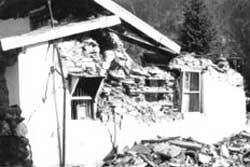Quaking mountains
 geologists , earth scientists and earthquake engineers from all over the country gathered at Shimla on October 14-15 for an interaction meet on natural hazards and their mitigation in Himachal Pradesh ( hp ). The meet was organised by the Wadia Institute of Himalayan Geology, Dehra Dun, and the hp state council for science, technology and environment.
geologists , earth scientists and earthquake engineers from all over the country gathered at Shimla on October 14-15 for an interaction meet on natural hazards and their mitigation in Himachal Pradesh ( hp ). The meet was organised by the Wadia Institute of Himalayan Geology, Dehra Dun, and the hp state council for science, technology and environment.
The Himalayas have experienced four great earthquakes of magnitude greater than eight in the last 100 years (Assam 1897 and 1950, Kangra 1905, Bihar-Nepal 1934). Of these the Kangra earthquake of Himachal Pradesh killed 18,815 people and caused extensive damage to property.
A minor earthquake is experienced in hp at least once in every six to eight years. Although exact prediction is still not possible, there is enough room for correct planning and adequate structural designing so that the impact of any natural calamity can be minimised. The government has always hesitated in spending money on mitigation, either at state or national levels. "The main reason for this is that money spent on relief is visible whereas that on mitigation is not,' said H Sinvhal, professor department of earth sciences, University of Roorkee.
"Spending a proportion of resources on creating public awareness regarding earthquake hazards, mitigation practices and strategies will go a long way in minimising the heavy losses suffered both in terms of human lives and property,' adds Sinvhal.
Proper seismic analysis is most of the times avoided while constructing a major public sector building or setting up a hospital, school or a colony. The suggestions from scientists are either not looked into properly or they get tied down by the red tape. In the Uttarkashi earthquake, for instance, all the school and college buildings were completely destroyed. The earthquake took place at 2.30 am. Had it happened during the day, most of the children would have died. Schools and hospitals should be at the safest places, and the construction should be the best possible because in case of any natural hazard they can be used as relief camps.
Introducing a small chapter at school level for basic information regarding earthquakes and an advanced chapter for all civil and electrical engineers in structural design was one of the recommendations which emerged from the session. Setting up of a disaster management centre and a network of 20 stations over four years was another notable recommendation.
In the words of V K Gaur, scientist at National Aerospace Laboratories, Bangalore, "An effective strategy for mitigating of disasters caused by natural hazards consists in the design and implementation of four related activities: advance action for long-term protection, preparedness for efficient response to a hazardous event that has happened or is about to happen, recovery and rehabilitation and research for improving prediction reliability as well as the design of appropriate engineering and social structures that would effectively embed in the local culture.'
Related Content
- Quake in China's Sichuan kills 13, including tourists, injures 175
- 8-magnitude quake may hit J&K: Study
- Death toll nears 400 as rescuers scramble to reach remote quake-hit parts of Pakistan, Afghanistan
- Strong earthquake hits eastern Indonesia
- Did Nepal Earthquake Change Mount Everest’s Height?
- Moderate quake hits Valley
